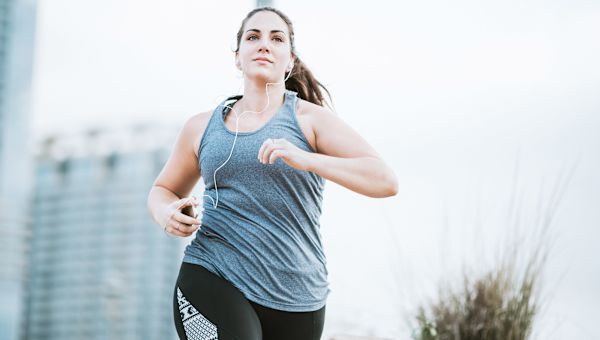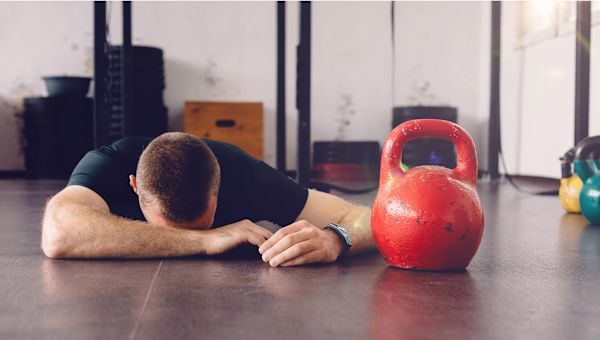8 easy tips to start exercising—even if you hate working out
No experience? No problem. Here are some tricks to help you get moving.

Exercise should be part of almost everyone’s weekly routine. It can help you maintain a healthy weight, lower your risk of injury and health conditions like heart disease and diabetes—and it makes you feel good. In fact, the U.S. Department of Health and Human Services (DHHS) recommends that all adults get at least 150 minutes of moderate aerobic activity or a minimum of 75 minutes of vigorous aerobic activity per week. Keep in mind if you can get closer to 300 minutes of week of moderate exercise or 150 minutes of more strenuous activity, it’s even better. In fact, the more exercise you get, the greater the health benefits, experts advise.
But what if you despise the treadmill? Or, what if you hate lifting weights? It’s okay—not everyone is going to run marathons or become bodybuilders. Any amount of exercise is better than none, the DHHS stresses. But most people can find an exercise that’s right for them—even if it’s a quick workout that can be done anywhere or a casual activity, like strolling. Gardening, dancing, walking the dog or climbing stairs all count toward your weekly physical activity goals, and will help reduce your risk for chronic health issues, like heart disease and diabetes.
Physical medicine and rehabilitation specialist David Steinberg, MD, of Saint Joseph Mercy Health System in Michigan talks through eight ways to jump-start your workout routine, no matter what your fitness level.

Get real about the benefits
Even if you despise sweating, it’s important to get moving to help lower your risk of chronic conditions like heart disease, diabetes and obesity. Exercise can help you do all of those things. “A strong, lean body is more resilient,” says Dr. Steinberg. "And exercise can reduce the amount of body fat you have, improve cardiovascular endurance and strengthen your bones, which helps prevent osteoporosis." Here are some of the other benefits:
- Helps you maintain good joint health
- Improves the health of your spine and back
- Lowers your risk of injury
- Increases flexibility and stability
- Releases endorphins, which improves your overall sense of well-being
- Increases HDL (good) cholesterol levels
- Reduces stress
- Lowers blood pressure
- Helps you get more sleep
- Improves brain function
- Encourages alertness and focus
What’s not to love?
Even if you’re not sure where you put your sneakers, here’s how to get started.

Schedule your workouts
The first step to making exercise a regular habit is setting aside time to work out—especially if you’re not too keen on it to begin with. “Use schedules and calendars to prioritize your workouts,” says Steinberg. "Mark off your calendar anywhere from 30 minutes to an hour each day. And it doesn’t all have to be at the same time." If it’s on your schedule—and coworkers and family members see that time blocked off—you’re less likely to be pulled into a meeting or pick-up duty. Not sure if morning or afternoon is best for you? Try both and see which time jibes with your schedule best.
Remember: there will be times when long exercise sessions won't be possible. On those days, try squeezing in a walk or set of stretches between meetings and activities. And keep in mind, when you make exercise a priority, you may sometimes have to push other things like straightening up the house to the backburner in order to stay committed.
No matter when you’re planning to work out, prep yourself for success the night before. If you’re an early-morning exerciser, pack your gym bag for work or lay out your clothes ahead of time.

Kick off an exercise group at work
A sedentary lifestyle can be detrimental to your health, raising your risk for heart disease, diabetes, anxiety, depression, cancer and obesity. That’s why it’s important to get moving—even at the office.
Start by moving more throughout the workday. Steinberg says there are walking and fitness groups at the hospital where he works. “We’ve developed something called the Summit Club—anyone who’s walked up the 11-story stair tower of the hospital can write their name at the top on the poster board, then keep track of how many times they’ve done it,” says Steinberg.
You can also set up walking meetings or lunch groups, and if there are fitness gurus in your office, have them lead a 30-minute exercise class once a week. If you’re a manager, encourage your staff to move. “If you’re able, make it easy for your workforce to be engaged in exercise, fitness and wellness,” advises Steinberg.

Start with an exercise in your wheelhouse
If you haven’t been very active in the past, creating a workout routine may be pretty daunting. “You have to spend some time thinking about the exercises that will be fun, engaging and energizing before you jump into them,” Steinberg says.
The easiest way to find exercises that are both doable and exciting is to uncover something in your wheelhouse. “Find exercises that you enjoy and that you are capable of," he says. "If you know you have problems with your back, hips or knees, running isn’t a good option, but swimming is.” Try several different workouts until you find one that you enjoy.
There are also free online resources that can help you learn new moves and techniques to spice up your workouts. A lot of health experts and bloggers offer no-charge workout videos and in-depth how-to instructional guides. Fitness websites and magazines are other possible resources.
Not sure where to begin? Check out American Council on Exercise’s exercise library to determine which ones are right for you. Remember, always consult your doctor or other healthcare professional before starting a fitness, nutrition, or weight management program to determine if it’s safe and appropriate for you.

Get outta your head
Having a negative experience is one of the most common reasons why people become afraid or stop working out, Steinberg points out. “Whether you’ve had an injury, you’ve worked out too hard and it took forever to recover or you didn’t get the results you were hoping to achieve after a strict fitness plan, it may be easy for you to come up with excuses not to work out,” he says.
If you’re easing back into exercise after a chronic or ongoing injury, remember to take it slowly at first—5 to 10 minutes may be all you need—and turn the intensity down a notch. Walking and swimming are great low-impact workouts that are easy on the joints. And physical therapists are good resources—they can help you understand your condition and learn which exercises will help you get back in the game and how to perform them safely and effectively.
When starting a new workout routine, think about what may have stopped you from continuing last time:
- Did you feel sore or get hurt?
- Did you have fun?
- Were you discouraged by your fitness level?
- Did you feel self-conscious at the gym?
- Did you get the results you were hoping for?

Create accountability
When it comes to your sweat sessions, a workout buddy, coach or personal trainer helps you define goals, stay motivated and share successes. They can encourage you to push yourself or try a new exercise you fear is too difficult. They can also hold you accountable: “Even just texting or emailing a close friend about the days of the week you’re planning to work out will help you keep your word," says Steinberg.
Workout classes are another option that can help you stick to your plan. Once you sign up, you’re probably not going to skip if you’re meeting a friend there, or if you’ve already paid for it.

Use social media and technology
Though Instagram and Facebook can keep you on your butt for hours scrolling through your feeds, there are some fitness benefits linked to social media. “Being connected to a larger community is helpful for establishing that accountability and creating a social environment where you are working out with others toward common goals and interests,” says Steinberg. Here’s how to use a few of the most popular resources:
- Facebook: If you’re taking part in local events like 5k fundraisers or walks, chat with other participants about how you’re preparing on the group’s page.
- Twitter: Search hashtags #health, #workouts and #fitness for workout routines and tips.
- Other apps and devices: In addition to wearable fitness trackers, phone apps can help you plan out your routes and interact with other exercisers.
Keep in mind, fitness gurus and online magazines often post free workout ideas to their social media pages, complete with how-to videos and instructional guides. Consider using these to spice up your current workout routines and to discover new moves that will tone different parts of your body.

Don’t disregard walking
Walking is free and doesn’t require much beyond a pair of supportive sneakers and a place to get moving. But this simple exercise offers many health benefits, including boosting your energy levels, improving oxygen flow through the body and strengthening your heart.
Steinberg recommends walking outside whenever possible. Exercising outdoors can be more strenuous thanks to hilly terrains. The fresh air can also boost your mood. If you’re wary of walking on busy streets or isolated trails, your local high school track may be a good place to start. To make your walks more interesting, listen to your favorite tunes or a podcast—you may not even realize you’re exercising.
A daily step goal on a wearable fitness tracker or on your phone could also offer motivation. If you’re just starting out, set a realistic goal and increase it gradually, or every two weeks. If you’re up for it, get competitive. Creating contests with family and friends to see who can take the most steps each day could help you meet or even exceed your goals.
More On


video

article

slideshow


video


video
